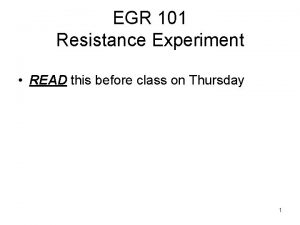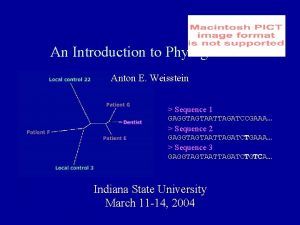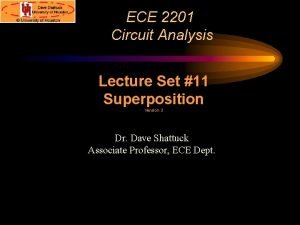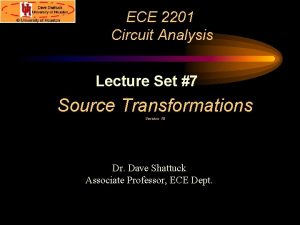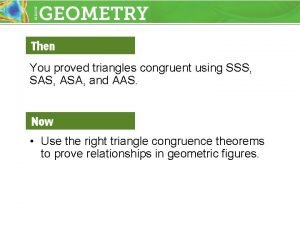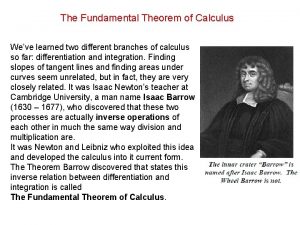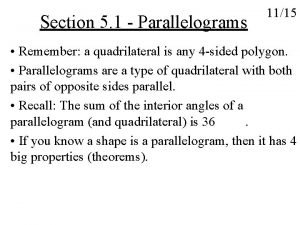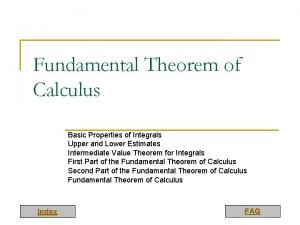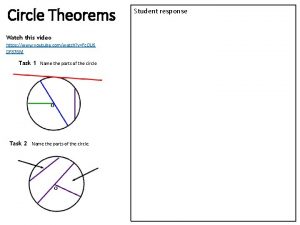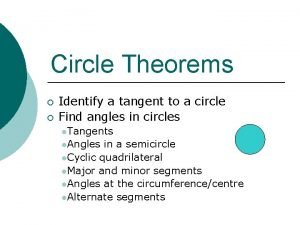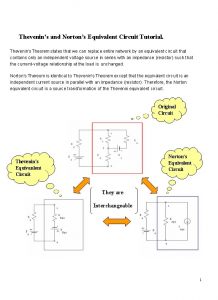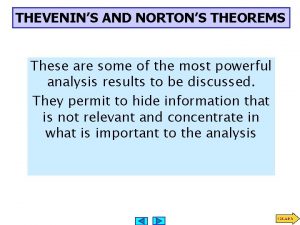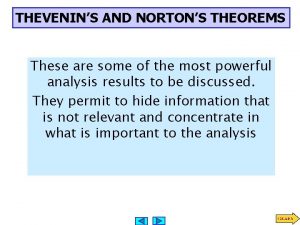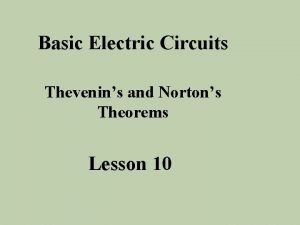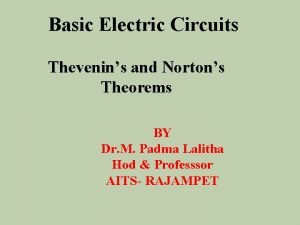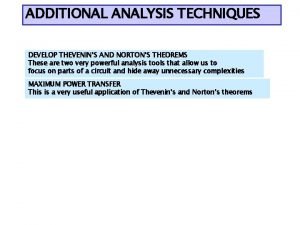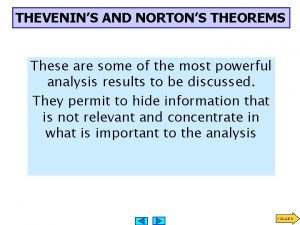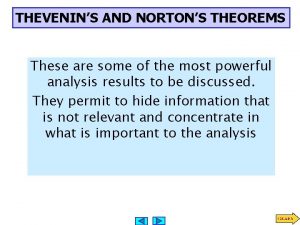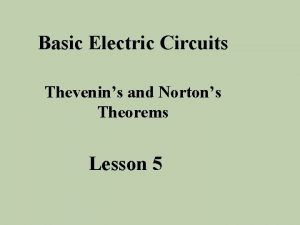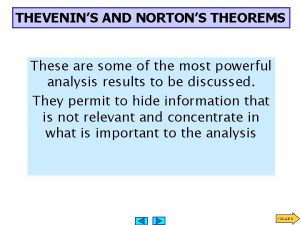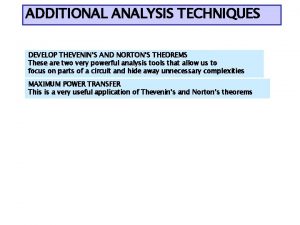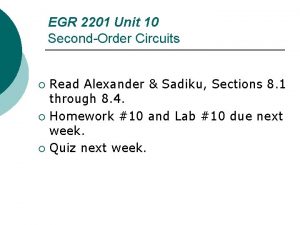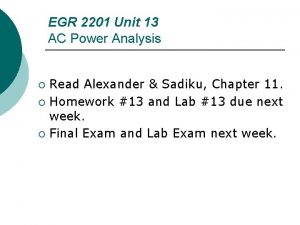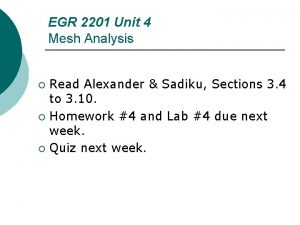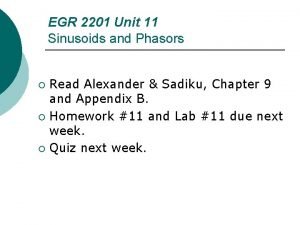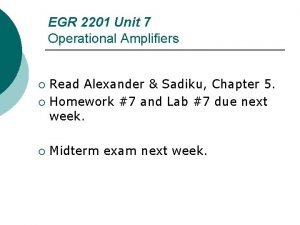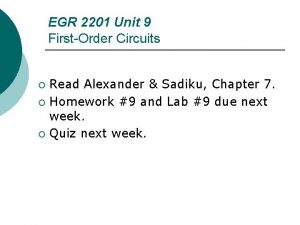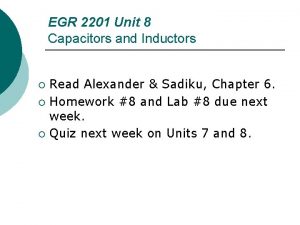EGR 2201 Unit 6 Theorems Thevenins Nortons Maximum



































- Slides: 35

EGR 2201 Unit 6 Theorems: Thevenin’s, Norton’s, Maximum Power Transfer Read Alexander & Sadiku, Sections 4. 5 to 4. 11. ¡ Homework #6 and Lab #6 due next week. ¡ Quiz next week. ¡

Techniques That Can Simplify Circuit Analysis ¡ Chapter 4 presents several new techniques: l Linearity Superposition Source transformation l Thevenin’s theorem l l Norton’s theorem Maximum-power-transfer theorem

Thevenin’s Theorem ¡ ¡ Thevenin’s theorem says that any linear two-terminal circuit can be replaced by an equivalent circuit consisting of an independent voltage source VTh in series with a resistor RTh. There’s a standard procedure for finding the values of VTh and RTh. But first, what exactly does this mean and why is it useful?

Load ¡ ¡ Often an electrical circuit or system contains an element (called the “load”) that can be varied while the rest of the circuit or system stays fixed. Example: When you unplug a lamp at home and plug in a hair-dryer, you’ve varied one small part of a huge electrical circuit that extends all the way back to the power plant. The lamp or hairdryer is the “load” part of the circuit.

What Thevenin’s Theorem Means ¡ Thevenin’s theorem lets us replace everything on one side of a pair of terminals by a very simple equivalent circuit consisting of just a voltage source and a resistor. Original Circuit Equivalent Circuit

Why It’s Useful ¡ This greatly simplifies computation when you wish to find values of voltage or current for several different possible values of a load resistance. Original Circuit Equivalent Circuit

Steps in Finding VTH and RTH 1. Open the circuit at the two terminals where you wish to find the Thevenin-equivalent circuit. (In the circuit shown, this means removing the load. ) 2. VTH is the voltage across the two open terminals. Pay attention to polarity! 3. RTH is the resistance looking into the open terminals with all independent sources turned off. • • Recall that to turn off a voltage source we replace it by a short. To turn off a current source we replace it by an open.

More on Step 3 (Finding RTH) ¡ The previous slide said that RTH is the resistance looking into the open terminals with all independent sources turned off. ¡ What about dependent sources? We don’t turn those off. ¡ As shown in the following two examples, how you find RTH depends on whether the circuit contains any dependent sources. l If no dependent sources, just combine resistors in series and parallel to find equivalent resistance. l If you have dependent sources, it’s trickier.

Finding the Thevenin-Equivalent Circuit Example #1: No Dependent Sources ¡ Goal: Find the Theveninequivalent circuit for the circuit in the book’s Figure 4. 27: ¡ Finding VTH: ¡ Finding RTH:

Finding the Thevenin-Equivalent Circuit Example #1: No Dependent Sources (Conclusion) ¡ We found that VTH = 30 V and RTH = 4 . ¡ So as far as the load is concerned, the original circuit below is equivalent to the simpler circuit on the right. Original Circuit Equivalent Circuit ¡ Question: Suppose you need to find the load current IL for six different values of RL. Would you rather analyze the left-hand circuit six times or the right-hand circuit six times?

Finding RTH For a Circuit That Contains Dependent Sources ¡

Finding RTH For a Circuit Containing Dependent Sources ¡ If a circuit contains dependent sources, follow these steps to find RTH. 1. Turn off all independent sources as previously described. 2. Connect an independent voltage source of any value vo (say, 1 V) across the open terminals. 3. Find the current io flowing into the circuit from the voltage source that you connected in Step 2. 4. To find RTh, divide the voltage vo by the current io. In symbols, RTh = vo ÷ io.

Finding the Thevenin-Equivalent Circuit Example #2: With Dependent Sources ¡ Goal: Find the Theveninequivalent circuit for the circuit in the book’s Figure 4. 31: ¡ Finding VTH: ¡ Finding RTH:

Finding the Thevenin-Equivalent Circuit Example #2: With Dependent Sources (Conclusion) ¡ We found that VTH = 20 V and RTH = 6 . So we conclude that, as far as any load connected to terminals a-b is concerned, the original circuit on the left below is equivalent to the much simpler circuit on the right below. Original Circuit Equivalent Circuit

Summary: Thevenin’s Theorem ¡ As we’ve seen, Thevenin’s theorem says that any linear two-terminal circuit can be replaced by an equivalent circuit consisting of an independent voltage source VTh in series with a resistor RTh. Original Circuit Thevenin-Equivalent Circuit

Techniques That Can Simplify Circuit Analysis ¡ Chapter 4 presents several new techniques: l Linearity Superposition Source transformation Thevenin’s theorem l Norton’s theorem l Maximum-power-transfer theorem l l l

Norton’s Theorem ¡ Norton’s theorem says that any linear two-terminal circuit can be replaced by an equivalent circuit consisting of an independent current source IN in parallel with a resistor R N. Original Circuit Norton-Equivalent Circuit

Not Surprising, Is It? ¡ Norton’s theorem follows from Thevenin’s theorem, since we can substitute a voltagesource-plus-series-resistor by a current- source-plus-parallel-resistor, or vice versa. (Remember source transformation? ) Thevenin-Equivalent Circuit Original Circuit Norton-Equivalent Circuit

Finding IN and RN ¡ Thevenin-Equivalent Circuit Norton-Equivalent Circuit

Techniques That Can Simplify Circuit Analysis ¡ Chapter 4 presents several new techniques: l Linearity Superposition Source transformation Thevenin’s theorem Norton’s theorem l Maximum-power-transfer theorem l l

Source and Load ¡ ¡ ¡ In many cases, we can think of an electrical system as being composed of a source of power and a load connected to that source. Examples of sources: amplifier, generator, power supply. Examples of loads: loudspeaker, electric motor, antenna.

Maximizing the Load Power ¡ Assuming the source is linear, we can replace the source with its Theveninequivalent circuit, giving us: Thevenin-equivalent of source ¡ Variable load resistance In many applications, we wish to maximize the power transferred from a fixed source to a variable load.

The Load’s Power Depends on the Load Resistance ¡ ¡ Question: For fixed values of VTh and RTh, what value of RL will result in maximum load power? l The answer is not obvious, since RL appears in both the numerator and the denominator.

Variation in the Load’s Power as RL Varies ¡ A graph of the equation looks like this: ¡ ¡ Note that power approaches 0 as RL approaches 0. Also, power approaches 0 as RL approaches . What is the value of RL where the graph peaks? . .

Maximum Power Transfer Theorem ¡

Matching Source and Load ¡ ¡ When source and load have the same resistance, they are said to be matched. In many practical applications, a major part of a circuit designer’s effort is to ensure that components are matched.

An Important Application of Thevenin’s Theorem: Source Modeling ¡ We’ve been using ideal voltage sources. These are theoretical models that maintain the same output voltage no matter what you attach to their terminals. l ¡ Symbols for ideal voltage sources: Such sources do not exist in real life. What about real voltage sources, such as batteries or power supplies? l To a first approximation, we treat them as ideal voltage sources.

Source Modeling ¡ ¡ For a better approximation, we treat a real voltage source (also called a “practical” voltage source) as an ideal voltage source in series with a resistor. This resistor is called the source’s internal resistance: the lower it is, the better. (Ideally, it is 0 Ω. )

Using Source Modeling to Analyze a Circuit ¡ Suppose we connect a load resistor across a real voltage source rated at 1 V. ¡ If we treat the real source as an ideal source, we’ll conclude that the voltage across the load resistor is 1 V. ¡ But if we take into account the source’s internal resistance, we’ll find that the voltage across the load resistor is less than 1 V.

A Practical Implication of This ¡ 1. 2. 3. We’ve seen that a real voltage source’s voltage will decrease when you connect it to resistors. Therefore, which is the better way to build a circuit on the breadboard? Method A Adjust the voltage source to the correct value. Build the circuit. Connect the voltage source to the circuit. 1. 2. 3. Method B Build the circuit. Connect the voltage source to the circuit. Adjust the voltage source to the correct value.

It’s Still Just an Approximation ¡ This model does not perfectly predict all aspects of a real voltage source’s behavior, but it gives more accurate results than treating the real source as an ideal source.

Making Graphs in Word 2013 (1 of 4) 1. Select Insert > Chart on Word’s menu bar. 2. Select X Y (Scatter). 3. Select Scatter with Smooth Lines and Markers. 4. Click OK.

Making Graphs in Word 2013 (2 of 4) 5. Type your data values in this window. 6. You can create a new plot on the same chart by typing a new column of data. (Not needed in Lab 6 but will be in future labs. )

Making Graphs in Word 2013 (3 of 4) 7. Close the data-editing window by clicking X. 8. If you need to re-open that window to edit your data, select Edit Data on Word’s menu bar.

Making Graphs in Word 2013 (4 of 4) 9. Add axis titles and a chart title by clicking the + and checking the boxes. 10. Edit your axis titles and chart title by clicking them and typing.
 Two technicians are discussing back pressure
Two technicians are discussing back pressure Bme egr
Bme egr Bme egr
Bme egr Egr 101
Egr 101 Egr 102
Egr 102 Local maximum and minimum vs. absolute maximum and minimum
Local maximum and minimum vs. absolute maximum and minimum Maximum likelihood vs maximum parsimony
Maximum likelihood vs maximum parsimony Maximum likelihood vs maximum parsimony
Maximum likelihood vs maximum parsimony Conrad fitzgerald academy
Conrad fitzgerald academy Ece 2201
Ece 2201 Api rp 510
Api rp 510 Ece 2201
Ece 2201 Ece 2201
Ece 2201 Ece 2201
Ece 2201 Biology 2201
Biology 2201 Erosion ej pratt
Erosion ej pratt Describe elie's encounter with the dentist
Describe elie's encounter with the dentist Ece 2202
Ece 2202 Unit 6 review questions
Unit 6 review questions Right triangle congruence
Right triangle congruence Trigonometric ratios maze answer key
Trigonometric ratios maze answer key The fundamental theorem of calculus
The fundamental theorem of calculus What is aa similarity theorem
What is aa similarity theorem Parallelogram theorems
Parallelogram theorems Define cyclic coordinates
Define cyclic coordinates Conservation theorem and symmetry properties
Conservation theorem and symmetry properties Leg acute angle congruence theorem
Leg acute angle congruence theorem Coplanar lines
Coplanar lines Angle theorems list
Angle theorems list 6-1 additional practice the polygon angle-sum theorems
6-1 additional practice the polygon angle-sum theorems Grade 11 geometry
Grade 11 geometry Theorem 4-4
Theorem 4-4 Fundamental theorem
Fundamental theorem Circle theorems geogebra
Circle theorems geogebra Angles in the same segment
Angles in the same segment Tangent of a circle theorem
Tangent of a circle theorem



